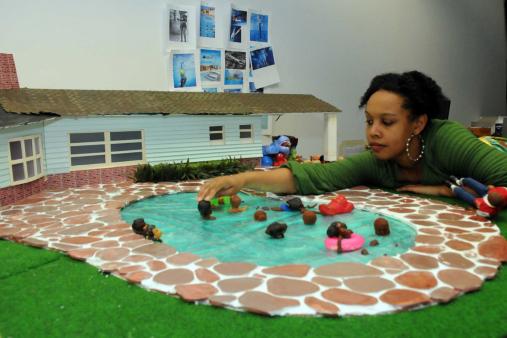Lauren Kelley creates animated videos that often feature Barbies altered by clay and confectioner’s sugar and that evoke a complex commentary on race, youth and desire. Kelley’s works also engage materiality and the craft of making miniatures. Her show True Falsetto is currently up at Women & Their Work through January 17th. I sat down with Kelley to discuss the show.
Katie Geha: Tell me a little about this show and the installation.
Lauren Kelley: I showed these videos in New York at The Kitchen and I really wanted the opportunity to show them in Texas, where I’m from. The title of the show, True Falsetto, is also the title of one of the videos screened. There is a series of digital light-jet prints that are collages, images from eBay or found scanned images. The videos and collage kind of work together. The way that the show is installed is so that the viewer can experience each on their own, but the videos and collages are in proximity enough so one can also grasp that they have a necessary relationship to one another.
KG: There’s always this acute attention to detail in the work, but it’s never airless. Do the collages come first?
LK: They work together. It’s just a desire to see it sketched, but they are created at the same time. Maybe there’s a problem I’m trying to work out in the video, so I decide to work on a collage.
KG: Do the collages help you work out narratives in the videos?
LK: The collages are like sketches, but then a lot of times there’s just no linear approach to telling a narrative and there’s no linear approach to arriving at a final video. I may spend months storyboarding a video and then find that nothing I storyboarded will end up in the video. Instead it’s just the springboard for the desire to cobble together objects that will be shot in the video.
KG: That makes sense. Your videos look really effortless, like they must be very fun to make.
LK: The way work progresses feels just like it’s tinkering. When I stay up late in the studio working, it’s just straight play.
KG: How do you create the sets? Are they based in your studio?
LK: My studio is definitely junky. They’re all over the studio. I’ve been doing car interiors so there is a build-up of that. I shoot in another place, so I can’t crowd myself out because I don’t throw these things out until the work is done. I don’t like throwing them out after doing all that work, but I also can’t live with them forever.
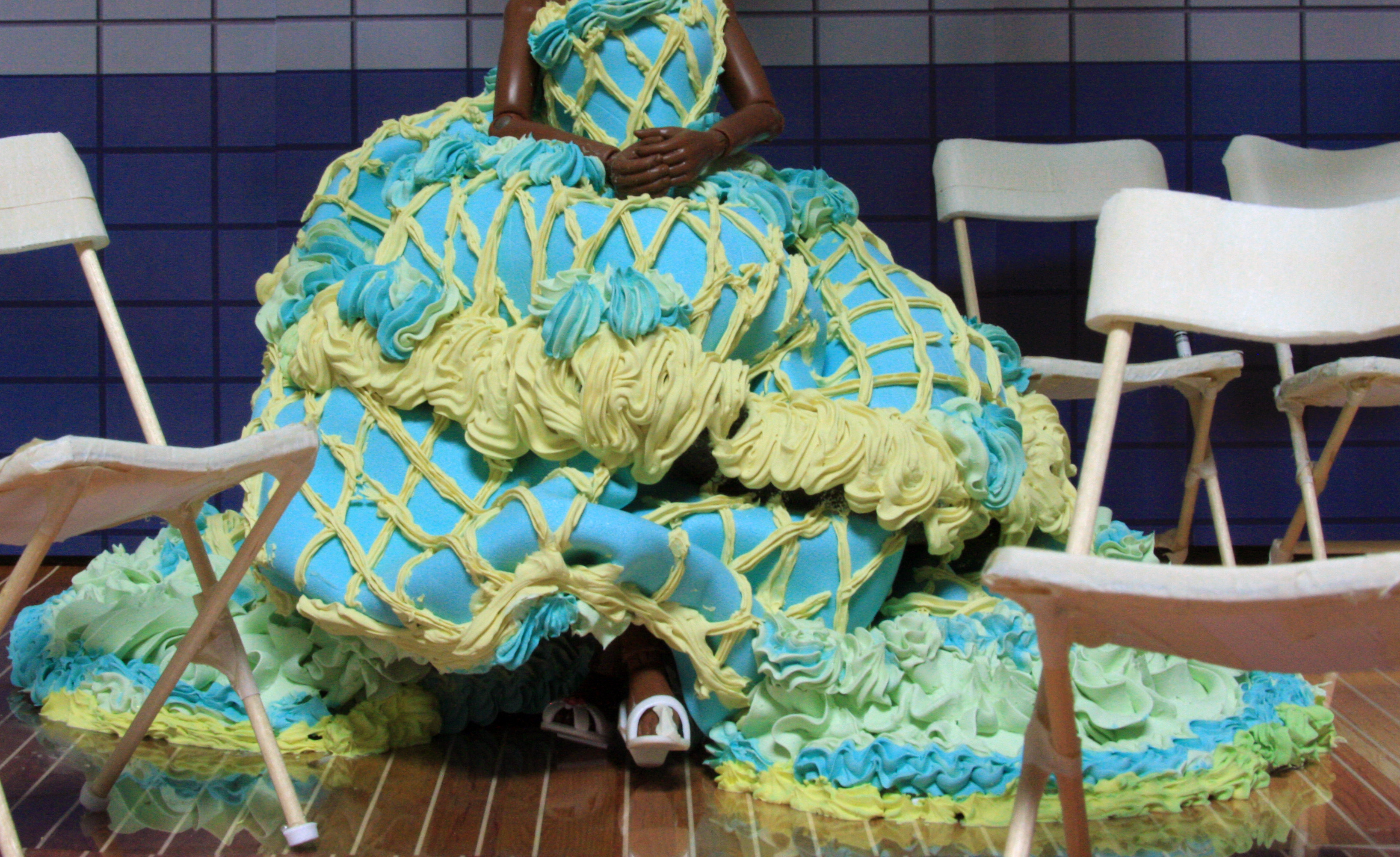
Still from Froufrou Conclusions (Wallflower) (2011) Single-channel video, 1 minute 29 seconds, projected dimensions variable
KG: Have you thought about exhibiting the sets?
LK: I have, but I just don’t like that Tim Burton behind-the-scenes look at it. It’s not really what the work is. Sometimes when the tinkering goes too far, I’ll make an actual object. I have shown sculptures in the round but nothing makes me more frustrated than work collecting dust. Even if they’re sold! So I like keeping these works in a hard drive. I look forward to someday being free from pragmatics to be able to put these objects into the world.
KG: Is there a specific story that you feel compelled to tell in your work?
LK: Not really. I feel like I’ve been building on this series of intentions in this body of work since 2006. At that time I thought it would strictly be about a cable access televisions show. More opportunities arose to create work in a conventional gallery setting rather than in television or film. So the context of the exhibition space really changed the way I make decisions. I hope that the narratives aren’t too similar. I like that there is a different story being told every time. But, yeah, the hand is consistent.
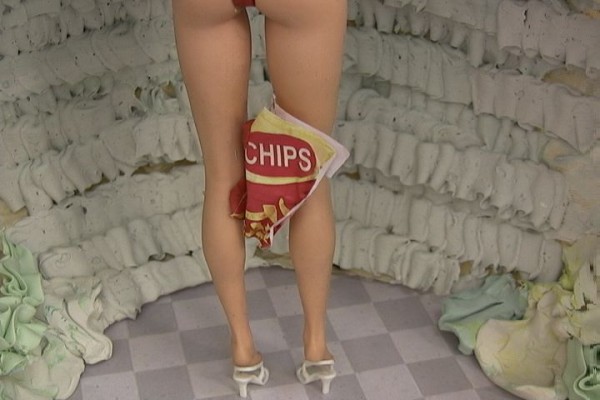
Still from Froufrou Conclusions (Chips) (2011) Single-channel video, 1 minute 29 seconds, projected dimensions variable
KG: You mentioned Todd Haynes’ animated short Superstar: The Karen Carpenter Story as a direct influence. What or who else are you looking at? Thinking about?
LK: This list can go on. I think that like with Haynes’ work I am attracted to people who make terms like perfection synonymous with grotesque verbiage. I’m loving Lee Friedlander’s work right now. I just read a great short story by Alice Munroe about turkey guts. I’m loving learning about Woody Guthrie‘s history and voice. This would probably be a different answer if I replied to it tomorrow.
KG: You have stated that you have an obsession with place or turf. How does turf play into your recent videos?
LK: I’d like to think that pulling from a lexicon associated with raw aggression gives my playful miniature efforts some sort of edge. By “obsession with turf” I mean that I enjoy figuring out ways to render an autonomous space. The characters I evoke are things/places/people that are working to preserve the niche they have attained or working to gain some sense of ground, if not encroaching upon someone else’s territory.
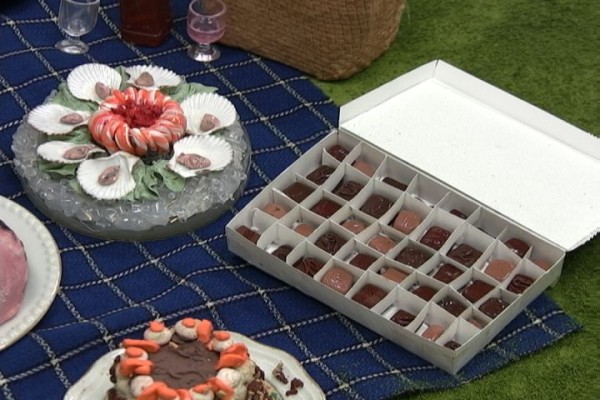
Still from True Falsetto (Eye contact) (2011) Single-channel video, 2 minutes 16 seconds, projected dimensions variable
KG: You make these amazing sets full of miniatures, almost a world in and of itself. In the video True Falsetto you directly reference the still life. What compelled you to examine such a tradition?
LK: Thank you. With True Falsetto I wanted to simply play with a delicious ruin. As this animated body of work grows I am eager to explore the multiple ways that a story can be told. That work started with the found sound that I reedited. I wanted the narrator’s voice to not be embodied by a doll or figurative presence. I wanted the narrator’s delivery to be a frame that (hopefully) sparked more oddity/curiosity. I decided that a still life is a compatible vehicle with a similar effect. To me, the still life is a great opportunity to play with the narrative that exists beyond the visual frame. Dutch Master still lifes never fail to have that sense of drama and texture and for this piece, it just made sense to make the still life a main character.
KG: Can you tell me more about the found sound in the video?
LK: This guy, Arthur Prysock, was a balladeer from the ’50s and ’60s. He was popular for doing voiceovers for beer commercials. He had a great album that was a series of songs to an anonymous lover. Each story was a little different and described his fantasies of being with this person. I don’t know if the person even existed. It was nice to hear this soft voice with this desire-filled narrative and this deep baritone beer commercial dude. I liked the contrast of that. Usually for my videos I write my own narratives. Lately I’ve been feeling like I don’t want to do that. I feel like the videos might be stronger if I look for other people’s narrative to re-interpret and find new ways to interpret with that same smudge and angularity.
KG: So, in a way, you’re working with found narratives, or stories that you find and then place with images?
LK: Yeah. I’ve been reading a lot more and thinking about what short stories I could interpret. It’s about going through speeches, magazines, short stories and stories on record on tape. Cutting, splicing and creating a new narrative. It started with the found sound and just this narrative of this man’s unfulfilled desire. I feel like academically that conversation comes up in a woman’s voice and I’m just tired of hearing that one.
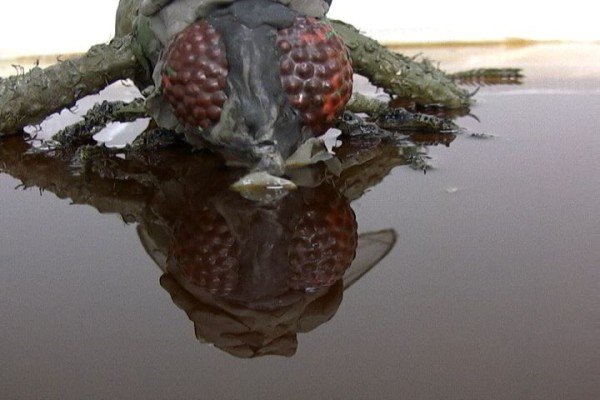
Still from True Falsetto (Eye contact) (2011) Single-channel video, 2 minutes 16 seconds, projected dimensions variable
____________
Katie Geha is a writer, curator and art historian living in Austin, Texas. She grew up in Ames, Iowa and received her MA in art history from the School of the Art Institute of Chicago and her PhD in art history from the University of Texas, Austin.


